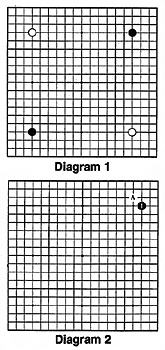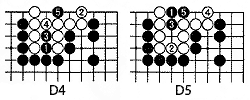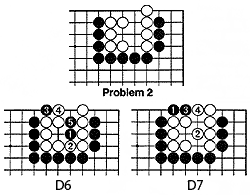Legends on origin of go (2)
Perhaps the most seductive theory about the origin of go is that it was based on ancient astronomical theories. These ideas probably originated with the star-worshiping Tang dynasty (ca. 700), which coincides with the time that go was introduced into Japan. They were eventually codified in The Classic of Go (published in China around 1050). Below is the first paragraph of this work."Generally speaking, when counting all things, one begins with the number one. There are, on the go board, 360 intersections plus one. The number one is supreme and gives rise to the other numbers because it occupies the ultimate position and governs the four quarters. 360 represents the number of days in the lunar year. The division of the go board into four quarters symbolizes the four seasons. The seventy-two points on the circumference represents the weeks of the calendar. The balance of yin and yang is the model for the equal division of the 360 stones into black and white."
This paradigm was further popularized in Japan by the playwright Chikamatsu Monzaemon in his play The Battles of Coxinga where he expands on these analogies by comparing the center point to the Polar star. Furthermore, the nine points on the go board, called "star points," were compared to the seven planets plus the sun and the moon.
In last week's column, I summarized the ideas of Peter Shotwell who contends that go's origins may be more solidly based on the ground than in the sky.
Shotwell points out that one of the many problems which makes the above theory of go's astronomical origins suspect is that the sizes of all the early boards found in tombs vary. Before 700 most boards were 17x17 lines, but even an 18x21-line board was once excavated as well as many 15x15-line boards. It was not until 700 that the go board was finally standardized to 19x19 lines.
Another problem that Shotwell points out is that the go stones found in the ancient tombs were green and red, and not black and white. Moreover, their shape was rectangular instead of round, as would most likely have been the case if they represented heavenly bodies.
According to Shotwell, the origins of go can be more consistently explained in the context of the Chinese "science" of geomancy, called feng shui (wind and water), which holds that there are living, active forces in the land, and in the shapes and colors of all things around us. A feng shui geomancer is supposed to be able to tell how ch'i (energy) is being blocked or attracted, influenced, deflected, trapped or repelled by various features of the landscape. Besides positive energy, there is also negative energy, and from his analysis the geomancer can tell if a particular location has good or bad "feng shui."
 Various terms in go--good shape, bad shape, influence, walls, solid territory--take on additional meaning if they are interpreted geomantically. This kind of thinking is more akin to the spirit of go than are the comparisons with the ineffectual stationary patterns of the stars and the irrelevant movement of the planets.
Various terms in go--good shape, bad shape, influence, walls, solid territory--take on additional meaning if they are interpreted geomantically. This kind of thinking is more akin to the spirit of go than are the comparisons with the ineffectual stationary patterns of the stars and the irrelevant movement of the planets.
Up until relatively recently, a game of go in China started with black and white stones being place in diagonally opposite corners as in Diagram 1. According to Shotwell, the reason this was done was to set up the feng shui for the game.
In the 11th century, the Japanese abandoned this custom and started their games on an empty board. Still, even today, a sense of feng shui is still retained in the ritual of the placement of the first stone by black. The first move is always played in the opponent's lower left corner, and, if this move is made on the 3-4 point, it is played at 1 in Diagram 2, away from the opponent, setting up a feng shui along the opponent's lower side. This is one of the first rituals learned by every go player. It is extremely rare to find an opponent who does not observe this.
Answers to last week's life-and-death problems

|

|
You might think that White 2 in the Variation diagram is the vital point, but Black plays 3, then makes a placement at 5. The white stones cannot make two eyes.
If Black makes a placement at 1 in the Failure diagram, White can live by playing 2 and 4. After Black 5, the position is a seki. That is, White cannot capture the black stones, but neither can Black capture the white stones. Hence, the white stones are alive.
 In Problem 2, Black must kill the white stones. This time Black must first make a placement at 1 in the Correct Answer. White plays 2 to stop Black from linking up, but Black hanes at 3. If White 4, Black plays 5, and White can no longer make two eyes.
In Problem 2, Black must kill the white stones. This time Black must first make a placement at 1 in the Correct Answer. White plays 2 to stop Black from linking up, but Black hanes at 3. If White 4, Black plays 5, and White can no longer make two eyes.
Starting with a hane at 1 in the Failure diagram lets White take the vital point of 2. If Black 3, White has two eyes after he plays at 4. If Black 3 plays at 4, White will play at 3. Again he has two eyes.
Honinbo title match
The fourth game of the Honinbo title match between Cho Chikun and Cho Sonjin was played on June 10 and 11.Cho Sonjin won by half a point to tie the series with two wins each.
